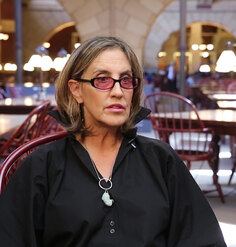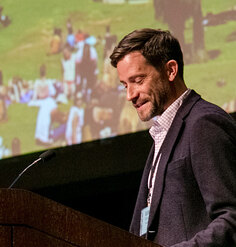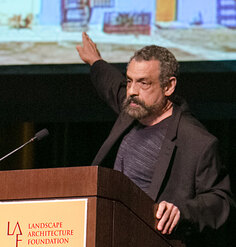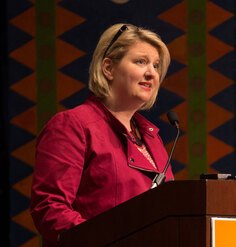Urban Ecology as Activism
By Kate Orff
This presentation was part of the Landscape Architecture Foundation’s The New Landscape Declaration: A Summit on Landscape Architecture and the Future held in Philadelphia on June 10-11, 2016. LAF asked a diverse group of leading minds to write a “Declaration” reflecting on the last half century and offering bold ideas for how landscape architecture can make its vital contribution in response to the challenges of our time.
Kate Orff
Founder and Partner, SCAPE
Director, Urban Design Program, Columbia University
New York, New York
Kate Orff is director of the Urban Design Program at Columbia University and founder of SCAPE, a 30‐person professional practice based in lower Manhattan. She holds a bachelor’s degree in political and social thought from the University of Virginia and a master of landscape architecture from Harvard Graduate School of Design.
*Affiliation at the time of the Summit
Urban Ecology as Activism
By Kate Orff
Nineteenth-century Olmsted parks shaped green civic spaces, forming a backdrop for an emerging democratic nation and defining the contours of the American city. Today, urban landscapes are newly pivotal in fostering an era where communities directly engage with the local environment, and where these spaces can be reimagined as productive landscapes that are not only pastoral settings but also active generators of social life. I envision an activist future landscape that gives form to citizen participation and grows in tandem with social networks. In the age of climate change, everyone is a landscape architect.
The book Toward an Urban Ecology (Monacelli 2016) maps our design process: exploring, defining, researching, and building these landscapes. Part monograph, part manual, part manifesto, it asks what the agency of the landscape architect is. How do we not just make landscapes, buildings, and public spaces, but make change? Landscape architecture is not just a discipline, it is a stance—a stance of activism.
We need to imagine a wholly different set of relationships with the earth relative to nothing less than the scale of humanity and our shared path forward. The effects of chemical pollution, energy extraction, water scarcity, poverty, extremism, species extinctions, and social fragmentation intertwine in a global feedback loop.1 We need not only the sharpened digital, design, and mapping tools of the landscape architect but also the tools of politics, science, storytelling, sharing, and collaboration to bring disparate groups together around a common purpose.
It will require Americans and other rich nations to consume less. It will require a rapid transition away from fossil fuels and toward less polluting forms of energy that occupy and affect our landscapes differently. It will require the proliferation of human rights and gender equity. It will require new land policy and legal concepts of landscape, not those formulated in the era of invisible hydrocarbon combustion. We need to abandon inherited picturesque concepts like viewshed, which interpreted in our legal system has doomed aquaculture, solar, and wind energy projects. It will demand sacrifice and new conceptions of pleasure, leisure, happiness, work, pain, time, and beauty. But landscape architects can help change the here and now and help society move toward a settlement pattern and mode of living that is both deeply joyful and deeply decarbonized.
We need to jointly conceptualize the physical and social and move past old notions of formal and informal, of maintenance and stewardship, to embrace a more complex understanding of landscape and community. Moving forward, landscape architects and urban designers can contribute to positive and purposeful civic-scale interventions, interweaving science, policy, people, and art. We need more projects like Living Breakwaters, a chain of protective breakwaters seeded with oysters, creating habitats designed to recruit finfish and shellfish and tended by high school science students. Such projects have emerged from a stance of informed creativity and an impulse to engage the world as it is, using contextual, holistic, and collaborative work processes. Living Breakwaters is in the preconstruction phase, advancing all components of the project with a tripartite purpose: risk reduction, marine habitat enhancement, and social engagement proceeding in concert. Projects of the future will be designed through different processes and will take very different forms when multiple purposes are taken as goals.
In this, as in all of our projects, we aim to overlay the regenerative capacity of living infrastructure with the methods of community organizing. Issues as massive as global climate change can feel well beyond our capacities to alter, but by bringing together large-scale strategic planning practices and community-based participatory initiatives, we can work together strategically to reverse ecological degradation and social fragmentation. The concept of civic landscape as a manageable scale of thought and action, which scales down to the unit of individual behavior and up to the frame of regional politics, remains full of potential. In this way, urban parks are redefined as next-century infrastructure, linking citizen participation with environmental prerogatives, cultivating a civic ethos of shared work, learning, play, and responsibility. Landscape architecture is seeding the next generation of engaged and environmentally aware civic stewards. Time to get to work.
1. Richard Misrach and Kate Orff, Petrochemical America (New York: Aperture, 2012).











